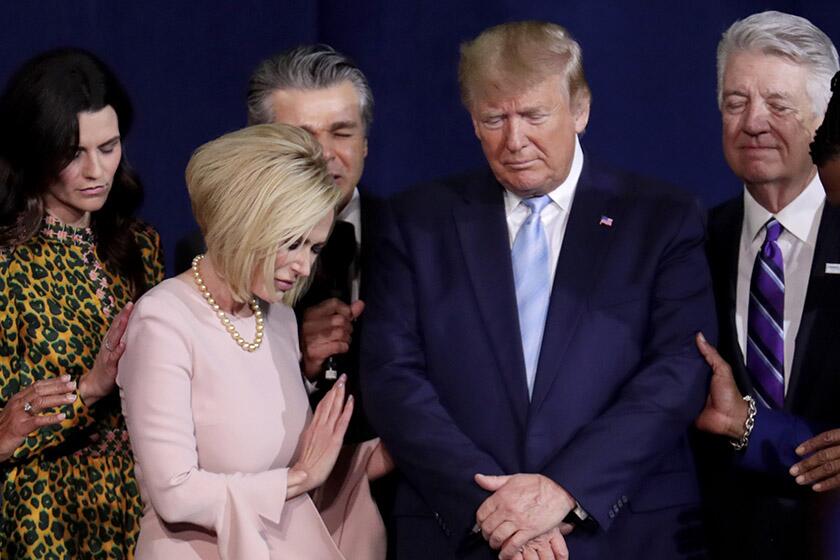Newton: Will L.A. tackle AEG?
The debate over whether to build a football stadium downtown is largely about costs and benefits. Are the additional traffic and other inconveniences associated with bringing one, or perhaps two, football teams to downtown worth tolerating in exchange for upgrading the city’s Convention Center, creating thousands of jobs and infusing new tourist dollars into the tax base? That’s a complicated but straightforward calculus, and at this point, most people who have studied the proposal think it’s a worthy and important project.
But that doesn’t mean that everyone is happy about it. AEG, the developer, has so successfully courted influence over the years that it’s hard to trust city and state officials to drive a hard bargain. The proposal cruised through the City Council (the mayor was tossing around a football before negotiations had even begun), and the company called on its friends in labor and the environmental movement to bring Sacramento on board.
At this point, the project has essentially come down to two votes. This week, the city Planning Commission will consider AEG’s environmental impact report. And by the end of the month, the City Council will have done the same. If they grant final approval, then all power over the project will be in the hands of AEG, so if there are concessions left to get, now’s the time to get them.
Most potential critics of the deal have melted away or been ground down by AEG’s connections. The Natural Resources Defense Council filed some responses to the environmental impact report but made it clear that its suggestions were for fine-tuning and not intended to block the stadium. Council members unanimously approved a memorandum of understanding that propelled the project forward. The mayor has supported it from the start.
There is still, however, a coalition of community groups pushing for further environmental and other concessions, a fight they say they will pursue with the city’s elected leadership and, if that fails, in court.
This group includes the Los Angeles Community Action Network, which works on behalf of downtown residents, especially the poor; the Legal Aid Foundation of Los Angeles, which provides free legal services to the poor; and Physicians for Social Responsibility, which is primarily concerned with potential health impacts of the stadium and its construction.
Leaders of the coalition are challenging the most basic assumptions of the project: They contend that the stadium will not benefit the Convention Center, will markedly deteriorate the quality of life in the surrounding neighborhoods and will not be much of a boon to the economy. “I can’t believe the City Council is buying the voodoo economics of this project,” said Dan Stormer, a veteran lawyer who is representing the project’s critics. Becky Dennison, of LA CAN, agreed and urged the council to slow down. “There’s always urgency,” she said. “It’s never about whether the community is being protected.”
And yet, even this group is not trying to prevent the project from being built. Instead, it’s trying to use these last leverage points to extract concessions that will make the stadium do more for the city and its residents. They want AEG to invest more in community parks and recreation. They want the company to pay all costs related to police officers and firefighters needed for security on game days. They want the company to be barred from tearing down nearby housing to build parking lots, which AEG has no plans to do, and for AEG to contribute $20 million to a housing trust fund that would create low-cost units close to the stadium. (It’s worth noting that the stadium would not destroy a single housing unit, so that’s a fairly brazen demand.)
AEG’s already agreed to dozens of community benefits, but if it won’t accept more, the project’s critics want the council to send the environmental impact report back for more work. And if that doesn’t work, they’re threatening to sue.
Of course, one person’s mitigation request is another’s idea of extortion. But the council has an obligation that supersedes saving the Convention Center or revitalizing downtown. It’s to protect the public treasury. In this case, that means not leaving any dollars on the table.
The coalition won’t get all it’s asking for. It shouldn’t. The council, however, needs to understand something it seems not to have fully grasped: The public is deeply skeptical that its elected officials are negotiating the best possible deal here because those officials are supported by AEG and its labor allies. There’s a way to address that skepticism. It’s to drive a hard bargain that brings maximum benefit to the city and still allows this project to proceed.
Jim Newton’s column appears Mondays. His latest book is “Eisenhower: The White House Years.” Reach him at jim.newton@latimes.com or follow him on Twitter: @newton_jim.
More to Read
A cure for the common opinion
Get thought-provoking perspectives with our weekly newsletter.
You may occasionally receive promotional content from the Los Angeles Times.







